Soundtrack for The Unknown Known
Your Monday morning needs a soundtrack and Danny Elfman’s score for Errol Morris’ The Unknown Known is just the thing. Available at Amazon or on iTunes.



This site is made possible by member support. 💞
Big thanks to Arcustech for hosting the site and offering amazing tech support.
When you buy through links on kottke.org, I may earn an affiliate commission. Thanks for supporting the site!
kottke.org. home of fine hypertext products since 1998.
Your Monday morning needs a soundtrack and Danny Elfman’s score for Errol Morris’ The Unknown Known is just the thing. Available at Amazon or on iTunes.
Saturday was the 20th anniversary of the death of Kurt Cobain at the age of 27. Many have written of the anniversary, but I liked Dennis Cooper’s piece published in Spin a few weeks after Cobain’s death.
Cobain’s work nailed how a ton of people feel. There are few moments in rock as bewilderingly moving as when he mumbled, “I found it hard / It’s hard to find / Oh well, whatever / Nevermind.” There’s that bizarre, agonized, and devastating promise he keeps making throughout “Heart-Shaped Box”: “Wish that I could eat your cancer when you turn black.” Take a look in his eyes the next time MTV runs the “Heart-Shaped Box” video, and see if you can sort out the pain from the ironic detachment from the horror from the defensiveness.
(via NYT Now app)
My friend Aaron has compiled an Rdio playlist of every song ever played on MTV’s Amp, a show from the mid-90s that featured electronic music. Lots of Underworld, Prodigy, Aphex Twin, and Orbital on here.
Some songs weren’t available on Rdio, but there’s more than 18 hours of music here.
A Clint Mansell soundtrack for a Darren Aronofsky film? Hell. Yes.
Mansell also did the soundtracks for Moon (my favorite of his, I think) and Requiem for a Dream. The Noah soundtrack is available for purchase on iTunes and Amazon.
Oh hello Grand Budapest Hotel soundtrack on Rdio. Alexandre Desplat. It’s a goooood morning.
Also available for download on Amazon or iTunes if that’s your thing.
A track called Computerized featuring Jay Z rapping over Daft Punk beats has surfaced. Take a listen:
I agree with Drew Millard’s take that this is an old unreleased track from the Tron Legacy / The Blueprint 3 days.
First, this isn’t an original Daft Punk instrumental; that keyboard line is a loop from the song “Son of Flynn” off of Daft Punk’s score for Tron: Legacy. From there, literally anyone-like, even me in GarageBand-could loop that, throw some drums in there, get a vocoder plugin and sing “computeriiiiiized” into it.
From there, let’s analyze Jay Z’s lyrics, which include the line, “I got an iTouch but I can’t feel,” and also a reference to Hov Jobs’ BlackBerry. Judging from the dated technology iHova is talking about on here, this is probably old as fuck.
On Friday, I mentioned listening to Nirvana with my kids. In January, Thomas Beller wrote a post for the New Yorker about introducing his two-year-old son to Nirvana.
Everything was going along fine in our living room until the song got to the break-the low, murky part-at which point Alexander called out to me, “Daddy! It’s scary!”
Nirvana’s music, in its anguish and energy, is scary. “Nevermind” is scary. But the break in “Drain You” is especially scary. I either had to turn it off or find a way to make this work. I didn’t want to turn it off. Instead, I turned it down an infinitesimal amount and addressed my son’s concerns.
“Alexander,” I said, bending over to talk near his face. “This is the part where they are in the swamp. The water is dark and murky, and the trees are low. They’re walking through the wet mud in the dark underbrush of the swamp.”
He looked at me with wide eyes. The colored lights added to the discotheque-meets-haunted-house mood. I worried that he would have nightmares, and that I would rue the night I played “Drain You.” People would shake their heads and say, “What were you thinking?”
“Right now, it’s very dark, but they are trying to find their way out of the swamp,” I continued.
That’s some top-notch parenting there. (via @futurerocklgnds)
An excerpt from a biography on Kurt Cobain about how he and Courtney Love met.
Already infamous in Portland, Love was holding court in a booth when she saw Kurt walk by a few minutes before his band was set to appear onstage. Courtney was wearing a red polka-dot dress. “You look like Dave Pirner,” she said to him, meaning the remark to sound like a small insult, but also a flirt. Kurt did look a bit like Pirner, the lead singer of Soul Asylum, as his hair had grown long and tangled — he washed it just once a week, and then only with bar soap. Kurt responded with a flirt of his own: He grabbed Courtney and wrestled her to the ground.
I was listening to some music with the kids the other day and Ollie saw the cover for Nevermind in my iTunes and asked, “hey Daddy, what’s that one with the floating baby?” So we played some songs and tried to explain what that album had meant to so many people, but I didn’t do it justice. How do you explain culture shifts to kindergarten-age children? “Everything was the same as it was before, except that everything was different. Does that make sense?” In the end, I pulled a power-dad move and said, “I guess you just had to be there.” ¯\_(ツ)_/¯
Jesse Hill made a music video for Beyonce’s Drunk in Love entirely out of emoji. Fantastic work.
Fist Eggplant! Poo! Surfbort! Oh man, that was fun.
The sheng is a free-reed wind instrument dating back to 1100 BCE in China. Using a modern sheng, Li-Jin Lee makes the ancient instrument sound remarkably like Super Mario Bros., including coin and power-up sounds.
And I know the Olympics are over and good riddance and all that, but this Mario Kart speedskating bit is great. Baby Park was one of my favorite tracks on Double Dash.
This Tumblr is collecting instances of experimental music on children’s television shows. Some personal favorites are Al Jarnow’s Cosmic Clock and Philip Glass on Sesame Street. (via @youngna)
For BEAT magazine, Gary Card drew an illustration of every hairstyle worn by Prince since 1978.
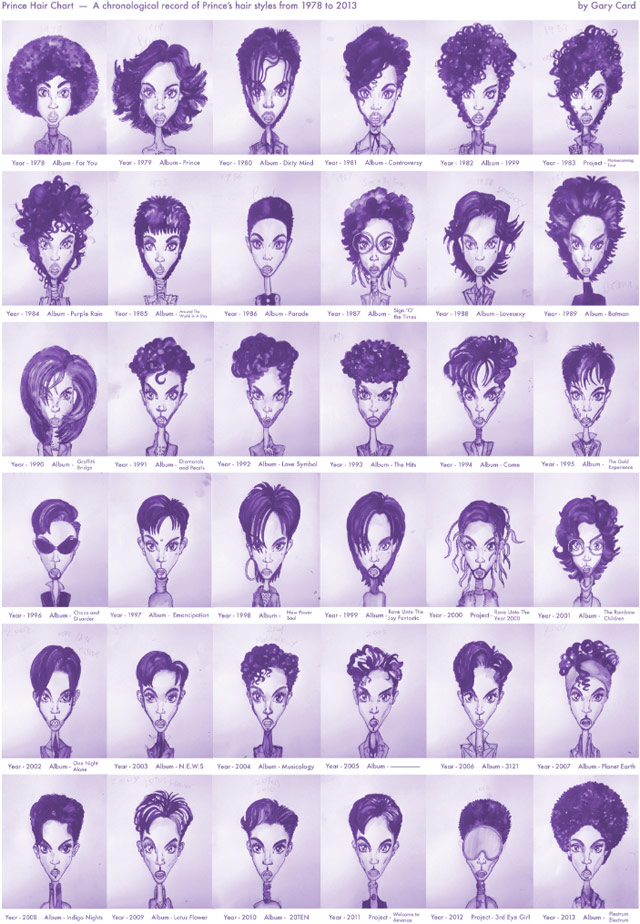
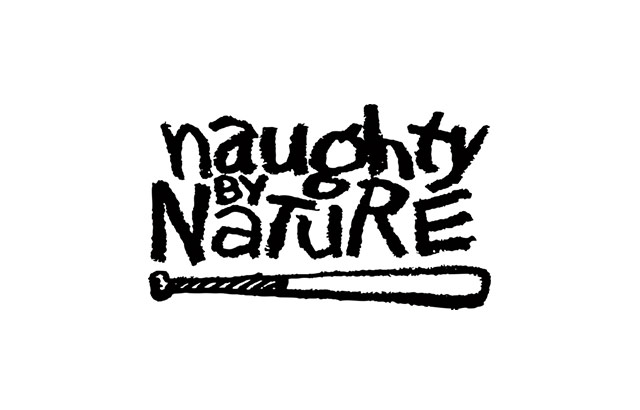
The Art of the Rap Logo is a collection of rap logos from NWA to Snoop Dogg to Def Jam.
In an interview with an Australian radio station, Arcade Fire’s Win Butler said that the music on the Her movie soundtrack will see an official release in some form. Here’s what Butler said about it:
We’re just slow as a band. The music will get out there, it’s just, like, a question of if we want to sell it to people or give to people or record other songs or whatever. There are many pieces on the soundtrack that are kind of based on actual songs that we’ve never really recorded. Yeah, there’s a song called Milk and Honey and a song called Dimensions that are, like, lost great Arcade Fire songs. They are actually just things that, like, fit the world of the movie and then we kind of wrote them to the film.
That’s good news! Here’s the whole interview (they start talking about Her at 15:40):
Mario Wienerroither takes music videos, strips out all the sound, and then foleys back in sound effects based on what people are doing in the video. You’ll get the gist after about 6 seconds of this Jamiroquai video:
Great stuff. He’s also done Nirvana’s Smells Like Teen Spirit, Prodigy’s Firestarter, and Queen’s I Want to Break Free. (via @faketv)
According to Spike Jonze, there might not be an official release of the soundtrack for Her (performed by Arcade Fire), but the whole thing is somehow currently on the internet for your listening pleasure:
Update: Win Butler of Arcade Fire now says the Her soundtrack will be released in some form eventually.
I always forget about Interview magazine but I really shouldn’t because a) Warhol and b) they consistently pair interesting people together for interviews. Case in point: director Steve McQueen (Shame, 12 Years a Slave, not Bullitt) interviews Kanye West for the Feb 2014 issue.
MCQUEEN: You’ve been on the scene as an artist now for 10 years, which is impressive, given the level of interest and artistry that you’ve managed to sustain in your work. In the process, you’ve become incredibly influential. So you talk about doing all of these other things, which is great, but there’s really no amount of money that could make you more influential than you are now. So my question is: What are you going to do with all of the influence that you have right now?
WEST: Well, influence isn’t my definition of success-it’s a by-product of my creativity. I just want to create more. I would be fine with making less money. I actually spend the majority of my money attempting to create more things. Not buying things or solidifying myself or trying to make my house bigger, or trying to show people how many Louis Vuitton bags I can get, or buying my way to a good seat at the table. My definition of success, again, is getting my ideas out there.
Thanks to Jonathan at The Candler Blog for the pointer; he also notes Glenn Kenny’s super-apt comment:
Clearly the problem with most Kanye West interviews up until now has been the interviewer.
In 1963, Studs Terkel interviewed a 21-year-old Bob Dylan, before he was famous.
In the spring of 1963 Studs Terkel introduced Chicago radio listeners to an up-and-coming musician, not yet 22 years old, “a young folk poet who you might say looks like Huckleberry Finn, if he lived in the 20th century. His name is Bob Dylan.”
Dylan had just finished recording the songs for his second album, “The Freewheelin’ Bob Dylan”, when he traveled from New York to Chicago to play a gig at a little place partly owned by his manager, Albert Grossman, called “The Bear Club”. The next day he went to the WFMT studios for the hour-long appearance on “The Studs Terkel Program”.
Dangerous Minds has more detail about the interview.
Bob Dylan is a notoriously tough person to interview and that’s definitely the case here, even this early in his life as a public persona. On the other hand, Terkel is a veteran interviewer, one of the best ever, and he seems genuinely impressed with the young man who was just 21 at the time and had but one record of mainly covers under his belt. Terkel does a good job of keeping things on track as he expertly gets out of the way and listens while gleaning what he can from his subject. It’s an interesting match-up.
Dylan seems at least fairly straightforward about his musical influences. He talks about seeing Woody Guthrie with his uncle when he was ten years old (Is this just mythology? Who knows?), and he mentions Big Joe Williams and Pete Seeger a few times.
Much of the rest is a little trickier. Terkel has to almost beg Dylan to play what turns out to be an earnest, driving version of “A Hard Rain’s a-Gonna Fall.” Dylan tells Terkel that he’d rather the interviewer “take it off the disc,” but relents and does the tune anyways.
(via @mkonnikova)
Nico Muhly is a young and celebrated classical music composer. His review of Beyonce’s new album is a pretty lyrical composition itself.
This is a beautiful song. On the video, there is a long introduction with piano and strings. Use real strings, please, Beyoncé. The piano might be real but it sounds like the most expensive fake piano on the market. One would love to think that this is a comment on the artificiality of beauty — we’ve become accustomed to an expensive fake in favor of the built-in and beautiful imperfections of reality — but I doubt that was the reason for this particular oversight. Bey: call me; you know where I stay.
(via @fchimero)
We may not have our jetpacks and hover cars, but our future-now has given us Tavi Gevinson interviewing Lorde and that’s just as good.
Tavi: On that note, you have a very unique way of looking at the suburb where you live, which I think you’ve called “the Bubble.” When did you realize the suburbs could be a source of inspiration?
Lorde: Well…this sounds so lame, but I grew up reading your blog, man! [Laughs]
Tavi: Oh no! “Ugh, that’s so LAME, shut up!”
Lorde: [Laughs] But no, I think there is something really cool about that whole Virgin Suicides vibe of making even the bad parts bearable. I hate high school so much, but there’s something kind of cool about walking around on the coldest day listening to “Lindisfarne” by James Blake or something and feeling like something has happened, even though it’s the worst thing ever. The album The Suburbs by Arcade Fire was influential to me in that as way well. I just think that record is really beautiful and nostalgic and so well-written. It’s a super-direct way of talking about what it’s like to grow up [in the suburbs], and I think that’s quite lovely.
You’re asking about stuff I’m not used to talking about in interviews, so I don’t have a stock way of driving the question.
Tavi: OK, then: “Do you feel 17?”
Lorde: AGHHHH! What do you even say to that, honestly?
Tavi: It’s kind of a trap, because if you say yes you’re shitting on their question by making it seem obvious, but if you say no you seem like you think you’re older and better.
Lorde: I always get these weird people being like, “Oh, she’s growing up way too fast, she looks 30.” Oh, god.
Tavi: People always say that. I remember — not to be all Mother Hen —
Lorde: No, go for it!
Tavi: I remember when people started paying attention to what I was doing, and it was like, “She should be getting knocked up like all the other kids her age!” It’s like, you complain when you think teenagers are stupid, and then when they try to do something, you’re all, “Oh, they’re growing up too fast, they don’t know what’s good for them.”
Lorde: It seems like a double standard to me. And there’s another part of it which I find really strange, which is that so many interviewers, even ones that I consider really intelligent and good writers, will do the, like, “Oh, you’re not taking your clothes off like Miley Cyrus and all these girls” thing, which to me is just the weirdest thing to say to someone. But then people will say, “She’s always talking about being bored, that’s petulant,” which I feel like is kind of taking the piss out of teenage emotions-just, like, making light of how teenagers feel. When people react that way about things that every teenager experiences, how can you expect to make anything good?
This oral history about Sir Mix-A-Lot’s hit Baby Got Back is way more interesting than it had any right to be.
Sir Mix-a-Lot: There was one event that really made me think that I should do a song about this, which was irritating the shit out of me. Amy and I were at a hotel on tour, when we saw one of the Spuds MacKenzie ads for Budweiser during the Super Bowl. You’d see these girls in the ad: Each one was shaped like a stop sign, with big hair [and] straight up-and-down bird legs. There’s nothing wrong with that, but I was so sick of that shit. Now, Amy never said anything about all this until she realized I was so in favor of her physique. She was an actress, and she started admitting that she felt like she lost a lot of parts because of her hourglass figure. I knew for a fact that many artists felt that if they didn’t use a skinny-model-type woman in their video, then mainstream America would reject the song. But I do not agree with that: If you look at Dolly Parton at her peak, a lot of white guys were like “daammn!” At the same time, when I did casting calls for videos, curvy women wouldn’t show up. They thought they didn’t have a chance. Unless you were in the hood, women who had curves — and I’m not talking about women who are shaped like me, with a gut, but women who ran five miles a day, with a washboard, six-pack stomach and a nice round, beautiful, supple ass — wore sweaters around their waist! Bottom line: Black men like curves. When they’re crooning to women about how beautiful they are in an R&B song, the ladies you see in the video don’t reflect what those guys like. Every time an R&B video was on, I heard women say, “I just saw him down in Oakland, and his girls wasn’t like that.” That made me think that this was more than a funny song, and it wrote itself.
Baby Got Back contributed to the cultural shift that changed that:
Sir Mix-a-Lot: Now, ass isn’t a big deal. I go to the gym, and I’ll hear a white girl saying to her trainer, “I want this to be round.” They realize that it doesn’t mean that you’re out of shape if you have a nice ass. Anybody who’s ever seen a stripper pick up a dollar bill with her ass knows you can’t do that with fat.
About half an hour ago, Beyonce surprised the world (the internet, really) by releasing her 5th album on iTunes. There are 14 songs and videos for every song. Just two days ago, Rolling Stone reported on Columbia Records Chairman Rob Stringer saying, “At some point, Beyonce will put a record out, and when she does, it will be monumental” interpreting that to mean ‘sometime in 2014.’ Not exactly.
I tried to find another example of a musician releasing a surprise album, but the results are polluted with references to Paul Simon’s ‘Surprise,’ which was likely no surprise at all.
Update: Last year at a show in Boston, Godspeed You! Black Emperor started selling copies of their unannounced new album. (thx, tomm)
Update: NME has a list of some other surprise albums. (via @kayluhb)
From Pitchfork, a list of the best album covers from 2013. My favorite is this one from Tyler, The Creator, which looks more or less like the opposite of a rap album.

I also liked Michael Cina’s cover for Fort Romeau (which he adapted from his very fetching art) and of course Yeezus, which is this year’s unignorable album in every way. (via @pieratt)
In celebration of his 44th birthday, Jay Z ranked his solo albums:
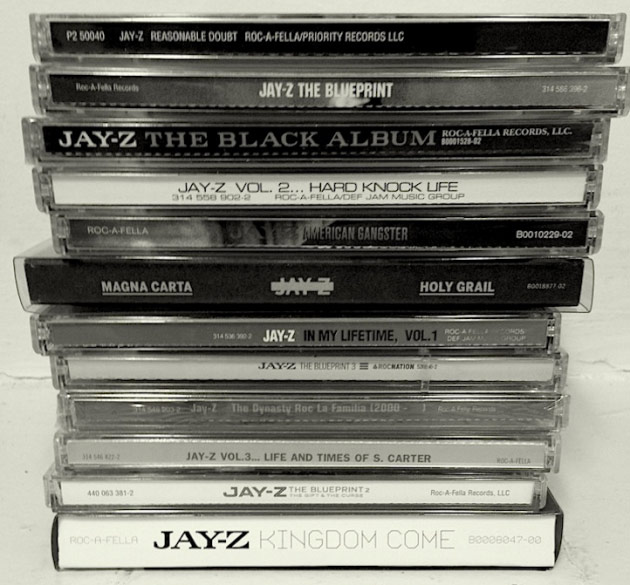
Here’s the annotated list:
1. Reasonable Doubt (Classic)
2. The Blueprint (Classic)
3. The Black Album (Classic)
4. Vol. 2 (Classic)
5. American Gangster (4 1/2, cohesive)
6. Magna Carta (Fuckwit, Tom Ford, Oceans, Beach, On the Run, Grail)
7. Vol. 1 (Sunshine kills this album… fuck… Streets, Where I’m from, You Must Love Me…)
8. BP3 (Sorry critics, it’s good. Empire (Gave Frank a run for his money))
9. Dynasty (Intro alone…)
10. Vol. 3 (Pimp C verse alone… oh, So Ghetto)
11. BP2 (Too many songs. Fucking Guru and Hip Hop, ha)
12. Kingdom Come (First game back, don’t shoot me)
(via @anildash)
In a masterfully edited video, David Ehrlich presents his 25 favorite films of 2013.
Fantastic. This video makes me want to stop what I’m doing and watch movies for a week. It’s a good year for it apparently…both Tyler Cowen and Bruce Handy argue that 2013 is an exceptional year for movies. I’m still fond of 1999… (via @brillhart)
From a 1968 film shot by director Jean-Luc Godard, here’s the Rolling Stones in the recording studio, working on refining Sympathy for the Devil.
(via openculture)
From Rap Genius, a chart showing mentions in rap songs of popular social sites and apps like Twitter and Instagram:
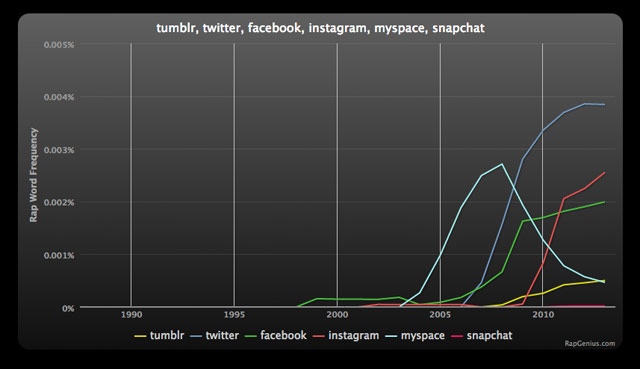
Compare with the graph for the same terms from Google News:
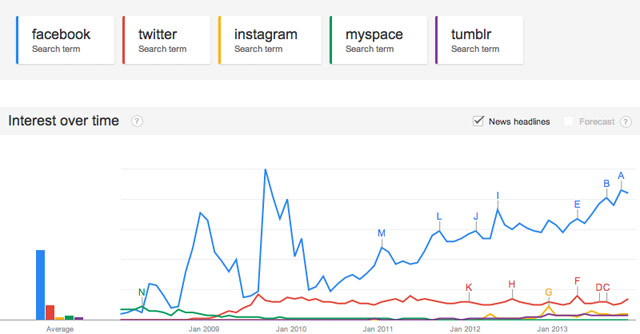
And here’s the graph for general search terms. (I excluded Snapchat from the Google graphs because Google wouldn’t allow 6 search terms at a time…it barely showed up in either case.) Twitter rules the rap roost, but Facebook demolishes everyone in general and news search traffic.
The Rolling Stones favorite American dish is something the band invented called Hot Dogs on the Rocks:

10 frankfurters
5 potatoes, or enough instant mashed potatoes to serve five
1 large can baked beansPrepare instant mashed potatoes, or boil and mash the potatoes. (Use milk and butter, making regular, every-day mashed potatoes.) Cook the frankfurters according to the package directions and heat the baked beans.
On each plate, serve a mound of creamy mashed potatoes ringed by heated canned baked beans. Over all the top of this, slice up the frankfurters in good-sized chunks.
Emily from Dinner is Served made some Hot Dogs on the Rocks; this is what the finished product looks like:

The recipe is from a 1967 “scene-makers cook book” called Singers & Swingers in the Kitchen (at Amazon). In addition to the Stones’ contribution, the book contained recipes like Paul Anka’s Party Spaghetti, Crepes Suzette by Liza Minelli, Leonard Nimoy’s Cold Soup Nimoy, and Barbra Streisand’s Instant Coffee Ice Cream. I dunno…I think I’d take burgers from Sinatra, Dean Martin, or even Hemingway over any of this celebrity fare. (via if charlie parker was a gunslinger)
When Nirvana appeared on Top of the Pops in 1991, they were asked to only sing the lead vocal over an instrumental track. The result was perhaps the most unusual performance of Smells Like Teen Spirit ever, with the band barely playing their instruments in sync with the music and Cobain doing his best Ian Curtis/Morrisey impression.
Pharrell has made a 24-hour music video of people dancing and lip-syncing that’s a cross between Christian Marclay’s The Clock and Girl Walk // All Day.
Stay Connected